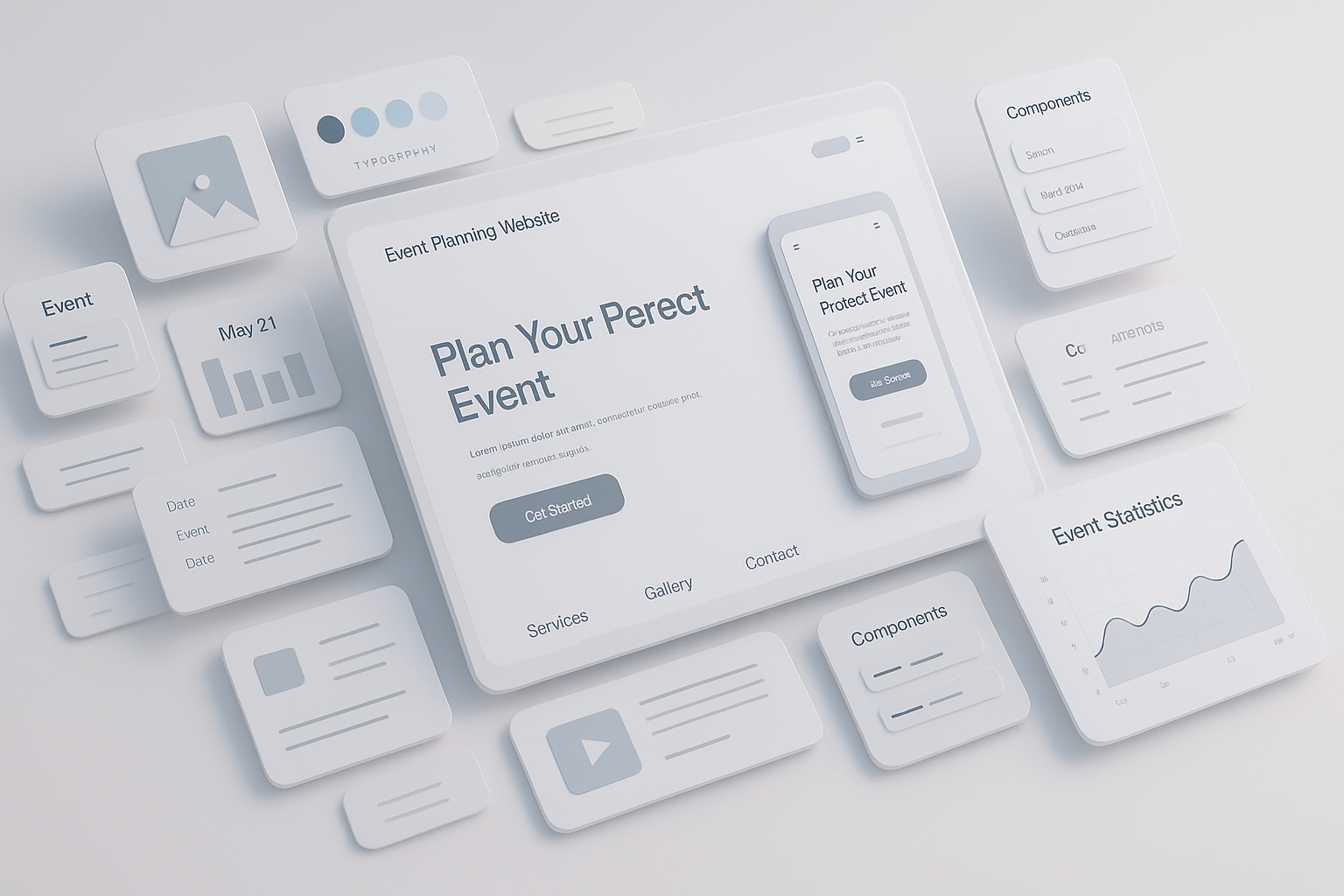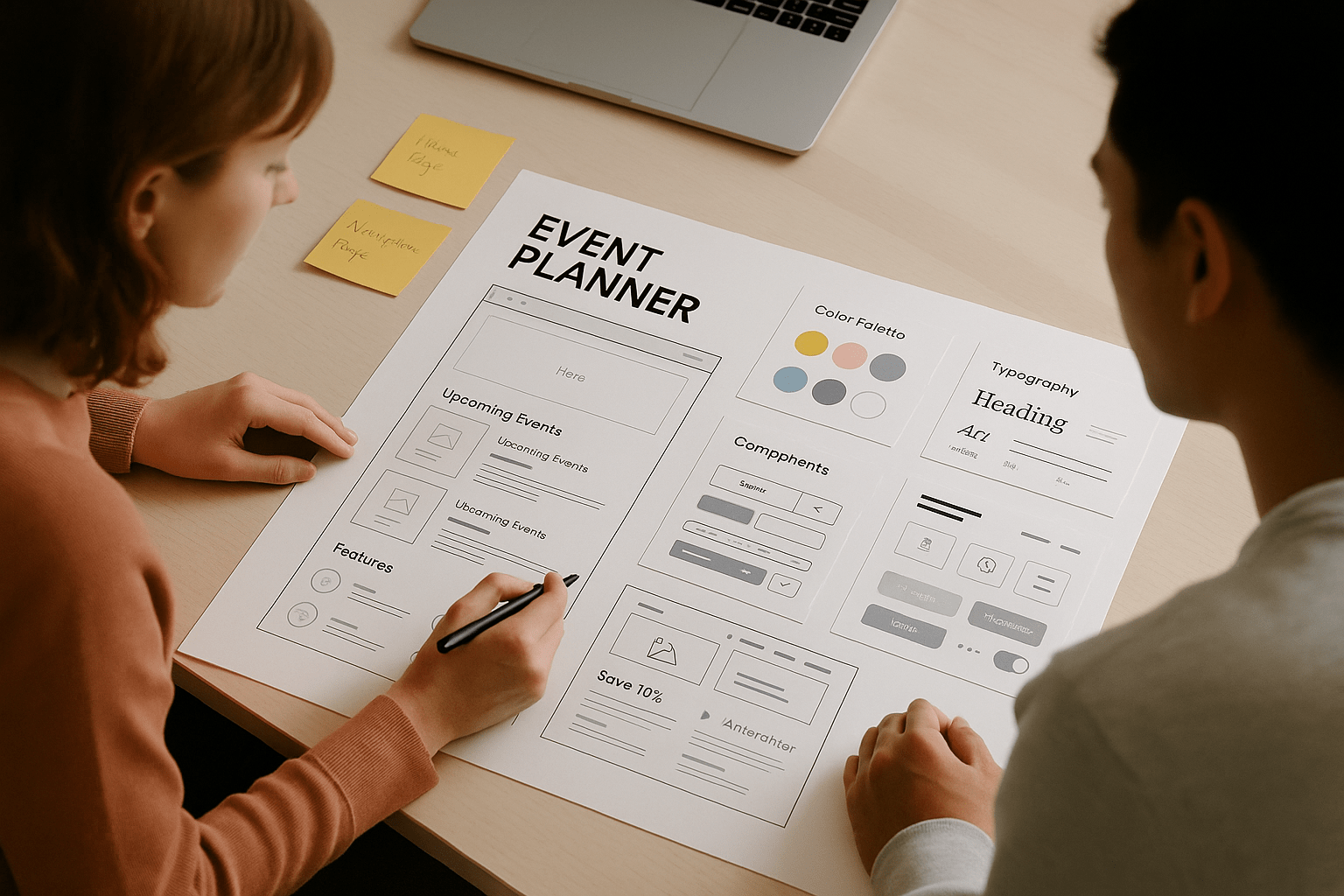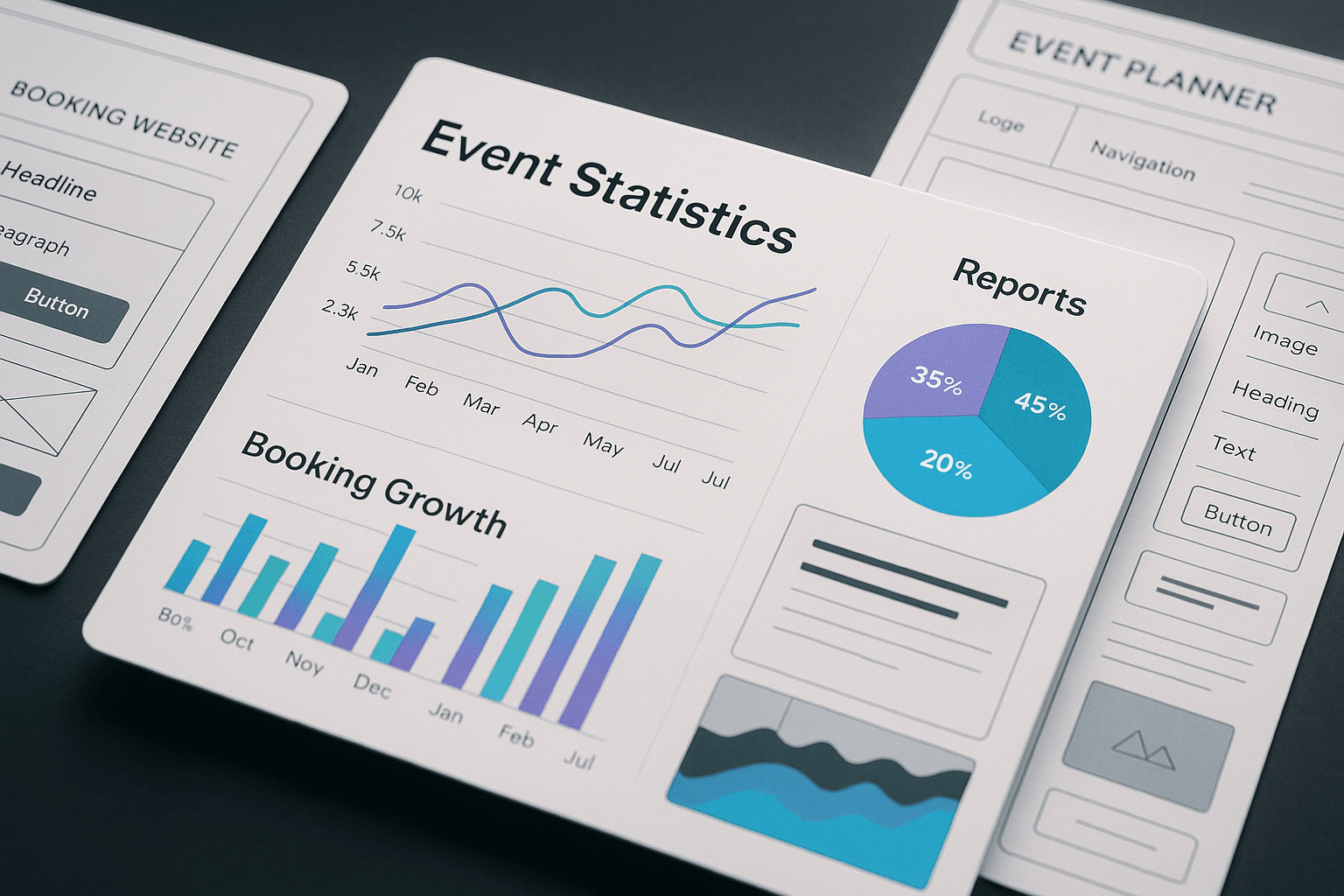UI/UX Design Strategies Every Event Planner Needs
by Design Delulu Editorial · September 14, 2025

Event planning is a complex, detail-oriented industry where first impressions matter tremendously. In today's digital landscape, your website and digital platforms serve as the gateway to your business, often determining whether potential clients choose you over competitors. UI/UX design isn't just about making things look pretty—it's about creating seamless, intuitive experiences that convert visitors into clients and streamline your business operations.
Event planners face unique challenges: managing multiple client touchpoints, showcasing diverse portfolio pieces, handling complex booking processes, and maintaining clear communication throughout lengthy planning cycles. Strategic UI/UX design addresses these pain points by creating user-centered solutions that work for both your clients and your business operations.

Why Event Planners Need UI/UX Design
Key Challenges Event Planners Face
Event planning businesses encounter several critical digital challenges that directly impact their bottom line:
- Complex Service Presentation: Unlike simple product-based businesses, event planners must showcase intricate services spanning venues, catering, entertainment, logistics, and coordination. Potential clients need to understand not just what you do, but how you'll make their specific event vision come to life.
- Multi-Stakeholder Decision Making: Event planning often involves multiple decision-makers—couples planning weddings, corporate teams organizing conferences, or families coordinating celebrations. Your digital platforms must accommodate different user types with varying needs and technical comfort levels.
- Portfolio Overwhelm: Event planners typically have extensive portfolios spanning different event types, styles, and budgets. Without proper organization and filtering systems, potential clients can feel overwhelmed rather than inspired by your work.
- Booking Complexity: The path from initial inquiry to signed contract involves multiple steps: consultation scheduling, proposal reviews, contract negotiations, and payment processing. Poor user experience at any stage can result in lost clients.
How UI/UX Design Solves These Problems
Strategic UI/UX design transforms these challenges into competitive advantages:
- Structured Information Architecture: Well-designed information hierarchy helps visitors quickly find relevant services and portfolio pieces. Clear navigation paths guide users from initial browsing to taking action.
- Personalized User Journeys: Different user types can follow tailored paths through your site. Corporate clients might prioritize efficiency and ROI information, while wedding clients focus on emotional storytelling and style inspiration.
- Smart Portfolio Organization: Interactive filtering, categorization, and search functionality help visitors find exactly what resonates with their vision, reducing decision fatigue and increasing engagement.
- Streamlined Conversion Processes: Optimized forms, clear calls-to-action, and intuitive booking flows remove friction from the client acquisition process, improving conversion rates and reducing abandoned inquiries.

Essential Features of UI/UX Design for Event Planners
Must-Have Design Elements and Workflows
- Visual Storytelling Through Portfolio Galleries: Your portfolio isn't just a collection of photos—it's a narrative tool. Implement grid-based galleries with hover effects revealing event details, before-and-after transformations for venue spaces, and client testimonials integrated with specific events. Include filtering by event type, budget range, guest count, and style preferences.
- Interactive Timeline Presentations: Event planning is inherently timeline-driven. Create interactive timeline components showing your planning process, from initial consultation through event day execution. This helps clients understand your methodology and builds confidence in your systematic approach.
- Multi-Device Responsive Design: Your clients will browse your services on phones during lunch breaks, tablets while commuting, and desktops during dedicated research sessions. Ensure consistent, optimized experiences across all devices, with touch-friendly navigation and fast-loading images.
- Integrated Communication Tools: Embed scheduling widgets for consultations, contact forms tailored to different service types, and client portal access points. Consider implementing live chat for immediate questions and FAQ sections addressing common concerns.
Real-World Implementation Examples
- Tiered Service Presentation: Instead of overwhelming visitors with every service you offer, organize offerings into clear tiers—Essential, Premium, and Luxury packages. Use visual comparison tables highlighting what's included at each level, making decision-making easier for potential clients.
- Location-Based Portfolio Filtering: If you serve multiple geographic areas, implement location-based filtering so visitors can see events you've planned in their specific region, building local credibility and relevance.
- Budget Transparency Tools: Create budget estimation calculators or range indicators that help visitors self-qualify while setting appropriate expectations. This reduces time spent on unqualified leads.

Common Mistakes to Avoid
Typical UI/UX Pitfalls for Event Planners
- Overloading Homepage with Everything: Many event planners try to showcase every service, testimonial, and portfolio piece on their homepage, creating overwhelming experiences that drive visitors away rather than drawing them in. Your homepage should be a clear entry point, not a comprehensive catalog.
- Generic Stock Photography: Using obvious stock photos of generic events undermines your credibility. Visitors can instantly identify stock imagery, which suggests you don't have actual work to showcase or attention to authentic representation.
- Complex Navigation Structures: Creating deep menu structures with multiple subcategories might seem logical from an organizational perspective, but users get lost in complex navigation. Most visitors should reach any important page within three clicks.
- Mobile-Unfriendly Forms: Long, complex forms that are difficult to complete on mobile devices result in high abandonment rates. Event planning inquiries often come from mobile users researching during personal time.
How to Do Better
Focus on Conversion-Driven Design: Every page should have a clear primary action you want visitors to take. Whether it's viewing your portfolio, scheduling a consultation, or downloading a planning guide, make that path obvious and compelling.
Implement Progressive Information Disclosure: Start with high-level information and allow users to drill down for details. Use expandable sections, modal windows, and linked detail pages to provide depth without overwhelming initial impressions.
Optimize Loading Speeds: Event planning websites are typically image-heavy, but slow loading times kill conversions. Implement image compression, lazy loading, and content delivery networks to maintain visual impact while ensuring fast performance.
Create Authentic Visual Content: Invest in professional photography of your actual events, behind-the-scenes planning processes, and team interactions. Authentic visuals build trust and differentiate your brand from competitors using generic imagery.
SEO and Growth Best Practices
Optimization Tips Specific to Event Planners
Location-Based SEO Strategy: Event planning is inherently location-dependent. Optimize for "event planner in [city]", "wedding coordinator [region]", and "[area] corporate event planning" search terms. Create dedicated location pages for each area you serve, featuring local venue partnerships and regional event examples.
Service-Specific Content Marketing: Develop comprehensive content around specific event types you specialize in. Instead of generic "event planning tips," create detailed guides like "Ultimate Corporate Retreat Planning Checklist" or "How to Plan a Destination Wedding in 6 Months."
Schema Markup Implementation: Use structured data to help search engines understand your services, locations, pricing, and reviews. Event planning businesses benefit from LocalBusiness, Service, and Review schema markup to improve search result visibility.
Local Partnership Integration: Feature venue partners, vendor relationships, and supplier collaborations prominently. These partnerships often provide valuable backlink opportunities and local SEO benefits while demonstrating your industry connections to potential clients.
Leveraging UI/UX Design for Visibility and Results
User Experience Signals Impact SEO: Search engines increasingly factor user experience metrics into rankings. Fast loading times, low bounce rates, and high engagement levels (indicating good UX) contribute to improved search visibility.
Content Organization for Featured Snippets: Structure your content to answer common event planning questions in formats that search engines can easily extract for featured snippets. Use numbered lists for processes, bullet points for tips, and clear headings for FAQ sections.
Internal Linking Strategy: Create logical internal linking paths that help both users and search engines understand your site structure. Link from service pages to relevant portfolio pieces, from blog posts to related services, and from testimonials to corresponding work examples.
Conversion Tracking and Optimization: Implement comprehensive analytics to understand how users interact with your site. Track not just traffic, but conversion paths, form completion rates, and client acquisition costs. Use this data to continuously refine your UI/UX approach for better business results.
The event planning industry thrives on relationships, trust, and flawless execution. Your website and digital platforms should reflect these same qualities through thoughtful UI/UX design that makes it easy for potential clients to discover, understand, and choose your services. By addressing the unique challenges of your industry through strategic design decisions, you create competitive advantages that translate directly into business growth.
Ready to transform your event planning business with strategic UI/UX design?
👉 Explore Design Delulu's UI/UX Design Services and discover how professional design can elevate your digital presence and drive more qualified leads to your business.
Additional Resources:
- View Our Design Portfolio - See examples of our UI/UX work across different industries
- Book a Free Consultation - Discuss your specific event planning design needs
- Design Tools & Resources - Access helpful design tools and templates